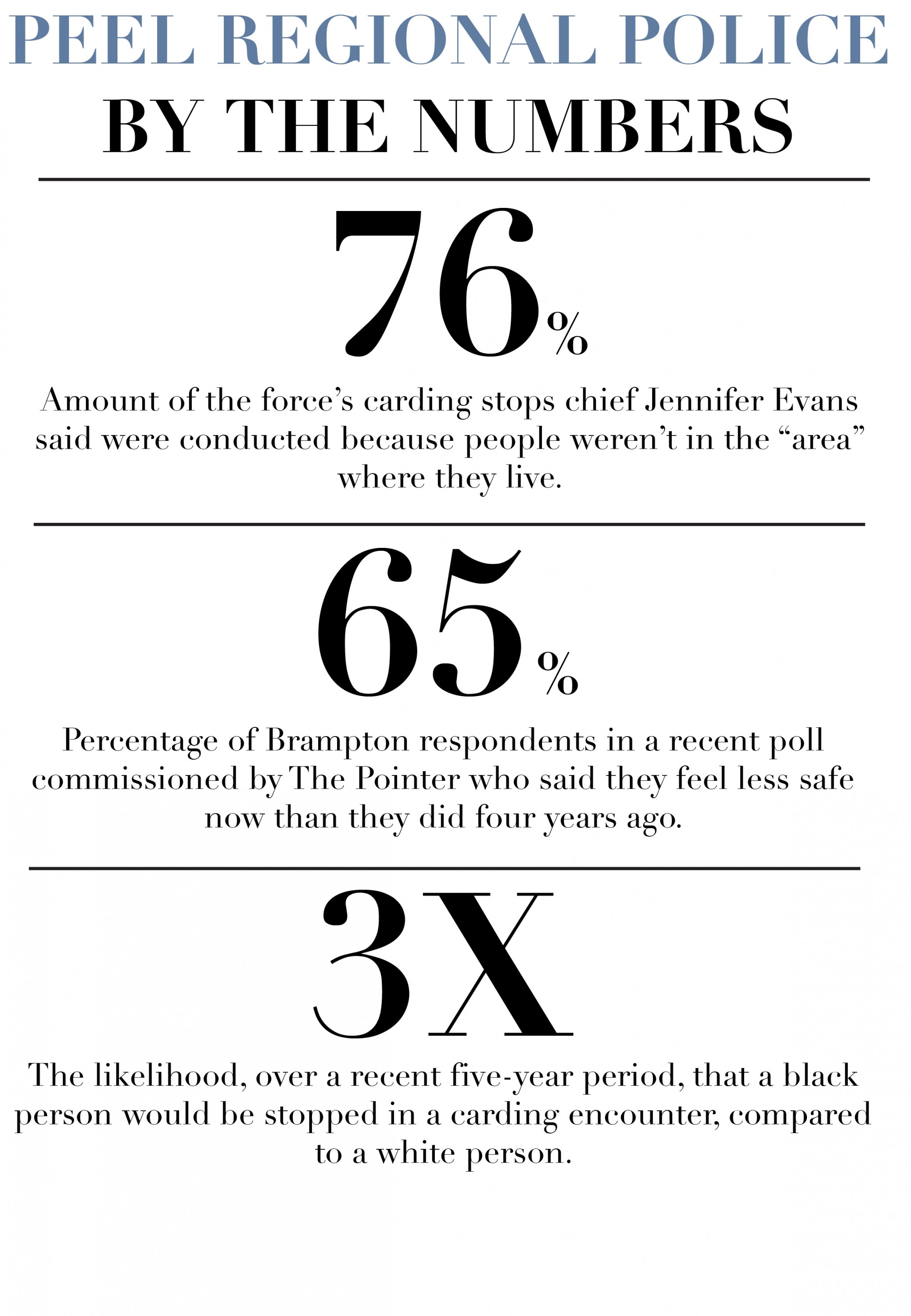
Questions hanging in the air about crime in Peel
With the election now over, it’s time to get on with the business of running the city, particularly tackling an issue that loomed large over the campaign: crime and policing.
Violence involving shootings spiked this summer, while in July two brazen bank robberies within a single week and then in August two more within an hour of each other left residents across the city on edge because bank hold-ups are generally a rare form of violent crime. “Carding,” the controversial practice of collecting personal information from people at random in the street, rose to public consciousness again, with Police Chief Jennifer Evans voicing her opinion, without evidence, that the spike in crime was linked to curtailing the practice. Then Evans announced she would step down on Jan. 11, raising questions about what direction Peel politicians will take when deciding who should replace the controversial head of a force plagued by police misconduct and racial discrimination allegations.
What happens next may depend in large part on Patrick Brown, who becomes mayor on Dec. 1. In September, then-candidate Brown pointed out that Peel Police were reporting that shootings had risen 11 percent over the previous year’s record pace. He tapped retiring city councillor Gael Miles to chair a task force on crime he planned to put into action should he be elected. He has vowed to ensure that carding is used only in the limited situations allowed under provincial guidelines, and not in situations that involve racial profiling. The force had been carding black individuals on the street at more than three times the rate, compared to whites and Evans could not explain why people were being targeted based on the colour of their skin. She later said publicly that her officers card people when they are not in areas where they live. She did not explain what was wrong with this or how her officers could know where people live before approaching them on the street.
Brown has also been vocal about the need to hire more police officers in Brampton. He repeatedly cites the disparity between the low number of officers per capita in Peel Region versus the province generally.
“We have 189 cops per 100,000 residents [in Ontario]. In Brampton, that [police number] is 133,” Brown said during a community question-and-answer session between police and the public in September.
Bramptonians attending the same session, held at the Springdale Library, vented their frustration about rising crime at the police officers present. One resident, Jotvinder Sodhi, complained about slow response times when crimes are reported, which he characterized as being measured in “days, not hours.”

Departing Mayor Linda Jeffrey, the day after the September community meeting, tabled a motion in Peel Region Council to request additional resources for policing from Michael Tibollo, who at the time was minister of community safety.
Evans was expected to attend the community meeting to answer questions about what her service needed to combat crime, but was a no-show.
Her tenure as chief has been checkered by comments she has made about street-checks, more colloquially known as carding. Critics say the practice only marginalizes minorities, especially young black men, who, statistics for the years 2009-2014 showed, were more than three times as likely to be stopped and carded, compared to whites.
That wasn’t the only controversial issue dogging Evans. There were also allegations of institutional racism, a rash of police misconduct cases, and various bungled investigations, particularly one into the murder of three members of the same family.
 The carding issue is part and parcel of a bigger problem for Peel Region police, namely that the police service doesn’t come close to being representative of the community it serves. Peel’s uniformed officers, for example, are only 13 percent visible minorities, whereas 74 percent of Brampton residents are visible minorities. A report to be released this week, called the Current State Inclusivity Assessment or Diversity, Equity and Inclusion Audit, may well verify fears of a worsening disparity between Brampton’s population and the officers who patrol its streets — further damaging public faith in the police service.
The carding issue is part and parcel of a bigger problem for Peel Region police, namely that the police service doesn’t come close to being representative of the community it serves. Peel’s uniformed officers, for example, are only 13 percent visible minorities, whereas 74 percent of Brampton residents are visible minorities. A report to be released this week, called the Current State Inclusivity Assessment or Diversity, Equity and Inclusion Audit, may well verify fears of a worsening disparity between Brampton’s population and the officers who patrol its streets — further damaging public faith in the police service.
The first question Brown and others who will sit on the post-election police services board will need to grapple with is how the next chief will be chosen. It’s a question fraught with tensions between traditionalists and those who think Peel policing needs a serious shakeup.
Six years ago, the last time the job was open, some observers had hoped the board would select a new chief from outside Peel; later, after Evans was hired from within the force, Peter Sloly, a progressive senior officer with the Toronto Police Service who had been in contention for that force's top job but left policing after he didn’t get it, was one name often mentioned to replace Evans.
Brown had not responded to The Pointer’s request for comment about a decision on a new chief by publication time.
Mississauga Mayor Bonnie Crombie served on the Peel Police Services Board for the first two years of her term as mayor and has signalled that she would like to return to the position at some point during her new term. She gave no indication as to whether she’d prefer to see an outside candidate become chief or someone promoted from within the troubled force.
However, her spokesperson, Natasha Mistry, did give a list of Crombie’s community safety priorities:
• Ensuring Peel Region Police are properly resourced to do their jobs effectively, while ensuring the safety of front-line officers
• Advocating on behalf of Peel Region Police to the province, to ensure we receive our fair share of funding to combat crime
• Ensuring the Peel Police Services Board works closely with the chief and the community to maintain a safe community, with a modern force people trust
• Working with the province to increase funding for crisis outreach and support programs to assist police with a rising number of mental health calls
• Calling on the federal government to get tough on handguns, especially trafficking and trade of illegal firearms
• Creating the Mayors’ Roundtable on Community Safety to regularly bring together the federal and provincial governments, along with community agencies involved in crime prevention, to coordinate advocacy efforts, share best practices, and work together to tackle crime and improve safety
• Reviewing youth recreation programming to see where the gaps exist and invest in more programming for at-risk youth.
• Supporting and shaping the Region of Peel’s Community Safety and Well-Being Plan
Crombie has pushed in the past to make the board’s budgeting process and policy decision-making more publicly visible, transparent and accountable. She made her biggest impact on the board when she pressed hard to modernize the force in 2015 and led the charge against carding, all against stiff resistance from Chief Evans.
The next meeting of the police services board is this Friday, Nov. 23, when many of the questions hanging in the air will be addressed.
Submit a correction about this story


